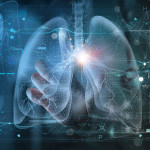Some good news regarding cancers: If antiretroviral therapy is able to maintain higher CD4 cell counts, it may reduce the risk of various non-AIDS-related cancers—notably those caused by other infectious diseases, human papillomavirus (HPV), for example—in people living with HIV. This is the conclusion of a study conducted by Michael Silverberg, MD, of the Kaiser Permanente HIV Initiative in Oakland, California, and his colleagues, reported Wednesday, February 17, at the 17th Conference on Retroviruses and Opportunistic Infections (CROI) in San Francisco.
To compare non-AIDS cancer rates among HIV-positive people with HIV-negative people in the general population, and to explore the connection between cancer risk and HIV-positive patients’ most recent CD4 counts and viral loads, Silverberg’s group sifted through data from the National Cancer Institute’s Surveillance Epidemiology and End Results (SEER) cancer registry and the records of more than 6 million Californians receiving care through Kaiser Permanente’s integrated health system. The researchers ended up including 19,230 HIV-positive and 202,313 age- and gender-matched HIV-negative patients in the analysis.
Ninety percent of those included in the analysis were male, and the average age in both groups was 40. Fifty-six percent of the HIV-positive individuals were white, compared with 47 percent of the HIV-negative individuals. The study subjects living with HIV were more likely to be smokers (39 versus 23 percent), to have abused alcohol or drugs (19 versus 8 percent), or to have hepatitis C virus (8 versus 1 percents) or hepatitis B virus (8 versus 1 percent).
Silberberg’s team first looked at differences between the two groups in terms of infection-related malignancies—cancers caused by infectious microorganisms, notably other viruses. The data were adjusted for age, sex, smoking, being overweight, alcohol/drug abuse and viral hepatitis.
Compared with HIV-negative controls, Silverberg’s group noted, people living with HIV were 75 times more likely to developed anal cancer caused by HPV, thought it is important to note that anal cancer is rare in the general population. They were also 17 times more likely to be diagnosed with Hodgkin’s lymphoma, caused by Epstein-Barr virus (EBV). And the risk of risk of oral/pharyngeal cancer, caused by HPV, was nearly doubled.
The risk of these cancers increased significantly with declining CD4 cell counts, indicating that antiretroviral therapy may be helpful in terms of minimizing the risk of various infection-related malignancies. For example, the risk of anal cancer among people with CD4 counts below 200 cells was 164 times higher compared with HIV-negative controls, whereas it was 83 times higher among those with CD4s between 201 and 499 and 34 times higher among those with CD4s of 500 or greater.
A similar trend was seen with Hodgkin’s lymphoma, notably a 55-fold increase among patients with CD4s below 200, compared with an 11-fold increase among patients with CD4s above 201. There was a tripling of the risk of oral/pharyngeal cancer among patients with CD4s below 200, a doubling of the risk in those with CD4s between 201 and 499, and no increased risk among those with CD4s of 500 or higher.
Viral loads—notably levels above 10,000 copies per milliliter (mL), between 501 and 9,999 copies/mL, and under 500 copies/mL—were also closely tied to the risk of infection-related cancers, further underscoring the potential role of antiretroviral therapy in reducing the risk of these malignancies.
The risk of cancers not typically caused by infections was also higher in people living with HIV compared with HIV-negative controls, although not nearly to the extent seen with some of the infection-related malignancies. The risk of melanoma was nearly doubled in people living with HIV, with a relative risk of 80 percent. There was a 40 percent increase in the relative risk of kidney cancer, a 30 percent increase in the relative risk of cancers of the blood, a 20 percent increase in the risk of lung cancer and a slight increase in the risk of colorectal cancer.
After adjusting the data for age, sex, smoking, being overweight, alcohol/drug abuse and viral hepatitis, Silverberg’s team documented relationships between HIV-positive patients’ CD4 counts and their risk of noninfectious cancers. The risk of lung cancer was tripled in patients with CD4s below 200 but was comparable with the risk seen in HIV-negative controls once the CD4 count was 201 or higher. The same went for colorectal cancer: A tripled risk was seen in those with CD4s below 200, but a similar level of risk was seen in those with CD4s above 201.
The opposite, however, was found with melanoma risk. When the HIV-positive patients’ CD4 cell count was below 200, the risk was comparable with that seen in HIV-negative individuals, but the melanoma risk nearly doubled when the CD4 cell count increased above 201.
Viral loads were less likely to have an effect on the risk of these cancers, though there were trends toward a lower risk of melanoma in those who had viral loads below 500 copies/mL compared with those who had viral loads in excess of 10,000 copies/mL.
Advertisement
Advertisement
Advertisement






Comments
Comments